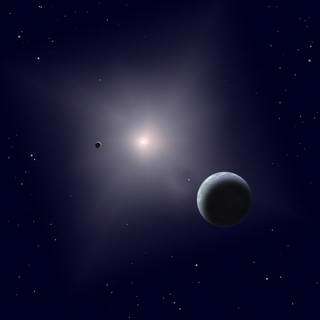Robotic Telescope Penetrates Heart of Universe's Most Powerful Explosion

Reporting in the May 12th issue of Nature, astronomers announced that they have penetrated the heart of the universe's most powerful explosion - a gamma-ray burst (GRB). Using the PAIRITEL (Peters Automated Infrared Imaging Telescope) robotic telescope on Mt. Hopkins, Arizona, they detected a flash of infrared light accompanying the burst of high-energy radiation that signaled the death of a star roughly fifteen times more massive than the Sun.
Image: A flash of high energy radiation from a massive dying star sterilizes an Earth-like planet too close to escape the blast in this artist's rendering. Credit: David A. Aguilar (CfA)
"This is the first time anyone has seen infrared light simultaneously with a gamma-ray burst," said Cullen Blake, graduate student at the Harvard-Smithsonian Center for Astrophysics and lead author on the paper. "This burst filled in a piece of the puzzle we didn't even know was missing."
The ability of PAIRITEL to quickly and automatically aim at an object of interest proved key to obtaining this result. PAIRITEL pointed in the direction of the burst minutes after the Integral gamma-ray satellite detected it. As a result, astronomers spotted infrared light from the explosion while the gamma-ray burst was ongoing.
"Gamma-ray bursts have been studied for 35 years, and we thought that GRBs were just that-a burst of gamma-ray and x-ray light," said Joshua Bloom (former Junior Fellow at the Society of Fellows and now Assistant Professor at UC Berkeley), who developed the PAIRITEL telescope. "Our new data offer a more expansive view-that whatever is producing the gamma rays is also capable of producing optical and infrared light."
Timeline of a Landmark Burst
On December 19, 2004, the orbiting Integral satellite detected the GRB and radioed its coordinates in the constellation Cassiopeia to astronomers worldwide. (The burst was also only the third burst to be localized by NASA's new GRB satellite, Swift.) The PAIRITEL telescope slewed to the coordinates as soon as it received the alert and within seven minutes of the start of the burst, PAIRITEL began observations. The GRB occurred somewhere in the field of view of PAIRITEL, but the precise position was not yet known.
"I was in a movie theater when I got a page that a burst had happened," said Blake. "As soon as I got home, I started looking at the images from the telescope and comparing them with older images at that place in the sky. Quickly I realized that we had something exciting!"
The images showed a new point of light in the area of sky of the GRB, one not present in archival images. Blake and Bloom then relayed the discovery to other astronomers, allowing others to train their telescopes on the precise position.
Intriguingly, the infrared light from that new source flickered during the first minute of observing, while the burst was taking place. That correlation implied that both the gamma rays and infrared light were coming from the same region near the exploding star.
Physics of a GRB
The picture that has emerged to explain GRBs is that when massive stars expend their nuclear fuel, they catastrophically collapse and form a black hole. Jets formed near the black hole plow outward and accelerate to velocities very near the speed of light. The jets contain relativistic winds that interact and collide, creating shock waves and emitting high-energy X-rays and gamma rays. If certain conditions arise, the shock waves may also generate infrared light.
Hours after the initial burst, PAIRITEL detected the traditional infrared afterglow from the GRB. An afterglow is generated when the jets hit shells of material surrounding the exploded star. Observations of GRB afterglows may offer astronomers a way of studying the environment immediately surrounding the bursts.
The PAIRITEL Robotic Telescope
Located at the Fred L. Whipple Observatory on Mt. Hopkins, Arizona, PAIRITEL is the first fully "robotic" infrared telescope in North America dedicated to observing transient astronomical events. The telescope, used for several years in a major all-sky survey (2MASS), has been refurbished to work autonomously. It is the largest robotic infrared telescope in the world, and the only one in the northern hemisphere.
One important goal of PAIRITEL is to study gamma-ray burst environments by looking at their light curves to determine how the brightness of a burst changes over time at different wavelengths of light. PAIRITEL facilitates such studies by taking images at several different infrared wavelengths simultaneously.
PAIRITEL also is designed to rapidly identify GRBs from the early universe in order to aid astronomers in studying the gas and proto-galaxies existing just after the first stars formed. Such bursts are thought to be incredibly rare, but as Bloom noted, "going after needles in the haystack like this is what literally keeps us up at night, especially when that needle is so extraordinary."
PAIRITEL demonstrates the power of combining a robotic ground-based telescope that can respond rapidly to an alert with a burst-detecting satellite like Integral or Swift. "Using PAIRITEL, we can start to ask bigger questions by studying the entire population of gamma-ray bursts," said Bloom.
With luck, PAIRITEL will detect more exceptional bursts like the one of December 19th. "This was a very special burst - one of the brightest and longest lasting bursts we've ever seen," said Blake. "We don't know how many more will come along during the lifetime of Swift, but we'll be ready for them!"
More information about PAIRITEL and the Swift satellite can be found at pairitel.org
Source: Harvard-Smithsonian Center for Astrophysics
















